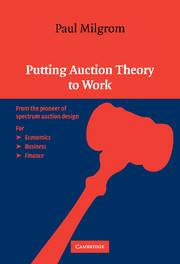Book contents
- Frontmatter
- Contents
- Preface
- Foreword by Evan Kwerel
- PUTTING AUCTION THEORY TO WORK
- 1 Getting to Work
- PART I THE MECHANISM DESIGN APPROACH
- 2 Vickrey–Clarke–Groves Mechanisms
- 3 The Envelope Theorem and Payoff Equivalence
- 4 Bidding Equilibrium and Revenue Differences
- 5 Interdependence of Types and Values
- 6 Auctions in Context
- PART II MULTI-UNIT AUCTIONS
- Bibliography
- Author Index
- Subject Index
- References
3 - The Envelope Theorem and Payoff Equivalence
Published online by Cambridge University Press: 05 June 2012
- Frontmatter
- Contents
- Preface
- Foreword by Evan Kwerel
- PUTTING AUCTION THEORY TO WORK
- 1 Getting to Work
- PART I THE MECHANISM DESIGN APPROACH
- 2 Vickrey–Clarke–Groves Mechanisms
- 3 The Envelope Theorem and Payoff Equivalence
- 4 Bidding Equilibrium and Revenue Differences
- 5 Interdependence of Types and Values
- 6 Auctions in Context
- PART II MULTI-UNIT AUCTIONS
- Bibliography
- Author Index
- Subject Index
- References
Summary
Mechanisms are defined very generally and can take a wide variety of forms. The sheer size and variety of the set of mechanisms would seem to make it hard to use in an economic analysis. Yet such uses are now routine, largely following the pattern set in the early analyses by Myerson (1981) and Holmstrom (1979).
Myerson had posed the following question: which mechanism should a seller use to sell a single indivisible good to maximize his expected revenue, if he can choose among all possible augmented mechanisms? To answer this question, known as the optimal auction problem, Myerson derived a lemma establishing that a certain payoff formula holds for all feasible augmented mechanisms at Bayes-Nash equilibrium and bounds the expected revenues associated with any mechanism. He demonstrated that standard auction designs with a well chosen reserve price sometimes achieve the bound.
Holmstrom asked whether any mechanisms besides the Vickrey–Clarke–Groves mechanisms could implement efficient decisions in dominant strategies. He, too, derived a lemma establishing that a certain payoff formula holds for all feasible mechanisms at a dominant strategy solution. He then demonstrated that only the VCG payment scheme prescribes payments consistent with that formula.
The two payoff formulas, which we will sometimes call Myerson's lemma and Holmstrom's lemma, are closely analogous to Hotelling's lemma and Shepard's lemma from demand theory. All four lemmas are derived from the envelope theorem. Each can be stated as either a restriction on a derivative or as a restriction on an integral.
- Type
- Chapter
- Information
- Putting Auction Theory to Work , pp. 64 - 97Publisher: Cambridge University PressPrint publication year: 2004



